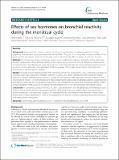| dc.contributor.author | Matteis, Maria | en_US |
| dc.contributor.author | Polverino, Francesca | en_US |
| dc.contributor.author | Spaziano, Giuseppe | en_US |
| dc.contributor.author | Roviezzo, Fiorentina | en_US |
| dc.contributor.author | Santoriello, Carlo | en_US |
| dc.contributor.author | Sullo, Nikol | en_US |
| dc.contributor.author | Bucci, Maria Rosaria | en_US |
| dc.contributor.author | Rossi, Francesco | en_US |
| dc.contributor.author | Polverino, Mario | en_US |
| dc.contributor.author | Owen, Caroline A | en_US |
| dc.contributor.author | D’Agostino, Bruno | en_US |
| dc.date.accessioned | 2014-08-13T13:59:58Z | |
| dc.date.issued | 2014 | en_US |
| dc.identifier.citation | Matteis, M., F. Polverino, G. Spaziano, F. Roviezzo, C. Santoriello, N. Sullo, M. R. Bucci, et al. 2014. “Effects of sex hormones on bronchial reactivity during the menstrual cycle.” BMC Pulmonary Medicine 14 (1): 108. doi:10.1186/1471-2466-14-108. http://dx.doi.org/10.1186/1471-2466-14-108. | en |
| dc.identifier.issn | 1471-2466 | en |
| dc.identifier.uri | http://nrs.harvard.edu/urn-3:HUL.InstRepos:12717548 | |
| dc.description.abstract | Background: Many asthmatic women complain of symptom exacerbations in particular periods, i.e. during pregnancy and menstrual cycles (perimenstrual asthma: PMA)". The goal of this study was to study the effect of the luteal and follicular phases of the menstrual cycle on bronchial reactivity (BR) in a group of asthmatic women. Methods: For this purpose, 36 pre-menopausal women were enrolled and underwent testing for resting pulmonary function, measurement of the diffusing capacity of the lung for carbon monoxide (DLCO), and airway responsiveness to methacholine in the follicular and luteal phases of their menstrual cycles. We also measured plasma hormone levels and levels of cyclic adenosine monophosphate (cAMP; a mediator of bronchial smooth muscle contraction) and testosterone in induced sputum samples. Results: Our study showed that about 30% of the asthmatic women had decreased PC20FEV1.0 in the follicular phase of menstrual cycle with a significant correlation between PC20FEV1.0 and serum testosterone levels. Moreover, marked increases in sputum testosterone levels (mean = 2.6-fold increase) together with significant increases in sputum cAMP concentrations (mean = 3.6-fold increases) were observed during the luteal phase of asthmatic patients, suggesting that testosterone contributes to the pathophysiology of PMA. We excluded the possibility that testosterone directly inhibits phosphodiesterase (PDE) activity as incubating PDE with testosterone in vitro did not reduce PDE catalytic activity. Conclusions: In conclusion, our data show that PC20FEV1.0 was decreased in the follicular phase of the menstrual cycle in about 30% of women and was associated with lower cAMP levels in sputum samples, which may contribute to bronchoconstriction. Our results also suggest a link between PMA and testosterone levels. However, whether these findings are of clinical significance in terms of the management of asthma or asthma worsening during the menstrual cycle needs further investigation. | en |
| dc.language.iso | en_US | en |
| dc.publisher | BioMed Central | en |
| dc.relation.isversionof | doi:10.1186/1471-2466-14-108 | en |
| dc.relation.hasversion | http://www.ncbi.nlm.nih.gov/pmc/articles/PMC4106209/pdf/ | en |
| dash.license | LAA | en_US |
| dc.subject | Perimenstrual asthma | en |
| dc.subject | Menstrual cycle | en |
| dc.subject | Testosterone | en |
| dc.subject | Phosphodiesterases | en |
| dc.subject | Cyclic AMP | en |
| dc.title | Effects of sex hormones on bronchial reactivity during the menstrual cycle | en |
| dc.type | Journal Article | en_US |
| dc.description.version | Version of Record | en |
| dc.relation.journal | BMC Pulmonary Medicine | en |
| dash.depositing.author | Polverino, Francesca | en_US |
| dc.date.available | 2014-08-13T13:59:58Z | |
| dc.identifier.doi | 10.1186/1471-2466-14-108 | * |
| dash.authorsordered | false | |
| dash.contributor.affiliated | Polverino, Francesca | |
| dash.contributor.affiliated | Owen, Caroline | |
| dc.identifier.orcid | 0000-0001-9686-5698 | |


